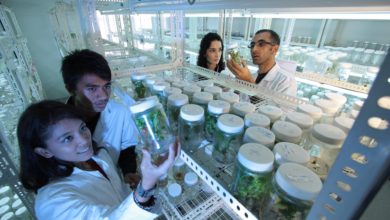Enhancing the Nutritional Value of Biofortified Pro-Vitamin A Rice through Metabolic Engineering in Food Biotechnology
Tharshi Sharvanandha

Carotenoids are a group of plant pigments important in the human diet as the only precursors of vitamin A. Certain carotenoids, most importantly β-carotene, are cleaved to vitamin A within the body and are referred to as pro-vitamin A (Aron et al,2005) vitamin A deficiency, a major problem in parts of the developing world, can result in permanent blindness and increase the incidence and severity of infectious diseases. (Rachel et al,2005).Vitamin A deficiency, a major problem in parts of the developing world, can result in permanent blindness and increase the incidence and severity of infectious diseases.(Rachel et al,2005).In Asia, vitamin A deficiency is associated with the poverty-related predominant consumption of rice, which lacks pro-vitamin A in the edible part of the grain(endosperm).Providing pro-vitamin A in a stable food such as rice could be a simple and effective complement to supplementation programs(Jessica and Adams,2005),(Edward and Hinchliffe,2005)because, through farming, it would be ubiquitous and self-sustaining.
Golden rice is the name coined to describe the genetically modified rice that (Jacqueline et al,2005) produces carotenoids in the endosperm of the grain, giving rise to a characteristic yellow color. In this pioneering work, a maximum level of 1.6μg/g total carotenoids were achieved and has not been surpassed in sub sequent experiments using alternative rice varieties. ( Sunandha and chagger,2005),(Rhian and Howell,2005).The limited production of pro-vitamin A in Golden rice is cited in the media as the major hurdle to the success of this particular solution for Vitamin A deficiency.(Sunandha and
chaggar,2005),(RhianandHowell,2005)

Phytoene synthase is thought to be limiting step for carotenoid biosynthesis in some wild-type tissue and is viewed as a major regulatory step(Fraser et al,2005)(a pathway diagram is shown in supplementary)figure01.This was the case in canola seed, where sole expression of crtB(the gene encoding a bacterial phytoene synthase)led to a substantial increase in carotenoid accumulation (Shewmake and Sheehy,2005),(Burkhard et al,2007)
In wild-type rice endosperm,the first barriers to carotenoid biosynthesis are both phytoene synthase and carotene desaturase, which are provided by the daffodil psy and crt1 transgene in golden rice.It is unknown what limits the further accumulation of carotenoid in golden rice. As no phytoene was accumulated(beyer et al,2005)
1.Impact of biofortification through metabolic engineering
Biofortification, the elevation of the levels of micronutrients in food crops through agricultural technologies, is advocated as a pivotal means to reduce micronutrient malnutrition. Impressive progress has been made in biofortification of mainly single micronutrients across an array of primary staple food crops. Biofortified crops have been developed via genetic
engineering. Although the later have yet to receive full approval for release to farmers. Biofortification via genetic engineering can enable high level accumulation of micronutrients and is not constrained by variation in available germ plasm. (Straeten, Bhullar,Steur, 2020)
Genetic engineering enables simultaneous augmentation of multiple micronutrients, along-with improving the post-harvest stability of vitamins, whilst also including agronomically important traits, such as enhanced yield and stress resilience. Metabolic engineering through transgenic technology enables multiple biofortification traits, including high iron, high zinc, high provitamin A, or high folate, to most biofortified crop varieties relatively quickly. As impaired micronutrient status aggravates susceptibility to infectious diseases including covid-19,the current pandemic further under scores the need to improve the nutritional status of poor rural populations and increase their nutritional self-sufficiency through staple crop biofortification. (Straeten, Bhullar,Steur, 2020)
2.Metabolic Engineering to increase carotenoid content
Due to the methylerythritol 4-phosphate (MEP)pathway, Geranylgeranyl diphosphate (GGDP)is produced. It is the substrate for phytoene biosynthesis, which is converted to all-trans-lycopene via a series of desaturation and isomerization reactions. (Watkins,Pogson, 2019)

MEP pathway provides the common precursor substrates for the synthesis of isoprenoids including carotenoids, chlorophylls, and tocopherols. (Bollineni,Krishnan, 2014) The most common methods used for carotenoid biofortification include the “push” strategy. With the help of this strategy genes early in the carotenoid biosynthesis. These are upregulated to force carbon into the pathway. With the help of “block” strategy, where the expression of genes directly down stream of desired compounds. (Datta,Paul,Ali,Gayen, 2012)
3.Carotenoid biofortification targeting retention and catabolism.
Recently the strategies of carotenoid are turning towards to the increasement of the retention of carotenoids. Increasing the stability of carotenoids, which may be a promising method of increasing carotenoid content in staple foods. (Watkins,Pogson, 2019)
4.Filling in biosynthetic gap towards provitamin A in rice
As an example;-how genetic engineering enable introduction of a micronutrient which is essentially absent in a golden rice.All photosynthetic tissues of all higher plants rice leaves produce and accumulate β-carotene. (Straeten, Bhullar,Steur, 2020)
5.Nutritional quality during storage
The rice stability of nutritional quality is very important during storage. During that process co-oxidation of β-carotene takes place when lipoxygenase oxidizes poly unsaturated fatty acid. With the help of reduced lipoxygenase activity to develop transgenic rice RNAi technology is being used. The reduced lipoxygenase effect on nutritional quality deterioration due to storage is being analysed. (Straeten, Bhullar,Steur, 2020)
Conclusion
Metabolic engineering, combined with conventional breeding, can catalyze a much more rapid approach to the realization of zero hunger and to reducing malnutrition by crop biofortification along the successful path paved by Harvest Plus and other public institutions. Biofortification, in combination with dietary diversification and nutrition education, holds great potential to eradicate micronutrient malnutrition and increase global human health. The next gene revolution should focus on sustainable solutions for malnutrition, as part of a humanitarian intervention, concerted with educational efforts as a cornerstone to halt population growth, improve living standards, and bring about global peace. west,Klemm, K.,( 2010)”
References.
1) Bollineni,Krishnan, H.,( 2014)”Marker assisted biofortification of rice with pro-vitamin A using transgenic Golden Rice® lines”: Progress and prospects. [online] ResearchGate. Available at: https://www.researchgate.net/publication/276840670 [Accessed 16 June 2021].
2) Datta,Paul,Ali,Gayen, K., (2012)”Genetically engineered rice with enhanced iron and carotenoids”[online] Research Gate. Available at: https://www.researchgate.net/publication/260457599 [Accessed 15 June 2021].
3) Naik, P., ( 2020)” Breeding and Bioengineering of male sterility in rice”[online] Researchgate. Available at: https://https;//www.researchgate.net/publication/343284411 [Accessed 15 June 2021].
4) OlCueto-Reaño,Trijatmikoiva,, N., (2020)”Molecular characterization and safety assessment of biofortifed provitamin A rice.” [online] Scientific reports. Available at: https://doi.org/10.1038/s41598-020-57669-5 [Accessed 13 June 2021].
5) Paine,Shipton,Chaggar, J.,( 2005)”Improving the nutritional value of Golden Rice through increased pro-vitamin A content” [online] nature biotechnology. Available at: <https://doi:10.1038/nbt1082> [Accessed 15 June 2021].
6) Straeten, Bhullar,Steur, D.,( 2020)’’Multiplying the efficiency and impact of biofortification through metabolic engineering” [online] https://doi.org/10.1038/s41467-020-19020-4. Available at: https://doi.org/10.1038/s41467-020-19020-4 [Accessed 10 June 2021].
7) Swamy,Samia,Boncodin,Marundan, M., (2019)”Compositional Analysis of Genetically Engineered GR2E “Golden Rice” in Comparison to That of Conventional Rice”[online] Agricultural and food chemistry. Available at: https://DOI: 10.1021/acs.jafc.9b01524 J. Agric. Food Chem. 2019, 67, 7986−799 [Accessed 15 June 2021].
8) Watkins,Pogson, J.,( 2019)”Prospects for Carotenoid Biofortification Targeting Retention and Catabolism”[online] cellpress reviews. Available at: https://doi.org/10.1016/j.tplants.2019.12.021 [Accessed 12 June 2021].
9) west,Klemm, K.,( 2010)”Vitamin A save lives.Sound science,Sound policy.” [online] World Nutrition. Available at: https://www.research.net/publication/284314746 [Accessed 14 June 2021].


